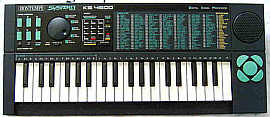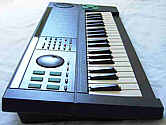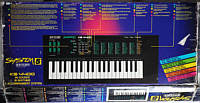Bontempi
KS 4600 (bad sounding wannabe sound bank keyboard
with lo-fi percussion)
Bontempi
KS 4400
Bontempi KS 4600
This noisy digital tablehooter from 1987 (CPU copyright date) would certainly
rank on one of the higher places in a "world worst keyboard" contest, because
despite this initially 199DM (about 100€) expensive wannabe sound
bank thing had 160(!) fancy named preset sounds, they all sound similar
and are made from only few static digital waveforms (resembling 2 mixed
sine waves) with very few and primitive volume envelopes.
All sounds are infested with strong digital aliasing noise and have audible
zipper noise. In unmodified state this thing yells ear tormentingly loud
out of its hollow roaring speaker unless you turn volume lower, but this
makes the sound even worse because the digital volume control steals bits
from the low resolution DAC. The percussion is made from low- res samples
and sound quite bassy; especially the tom drum distorts extremely and the
cymbal decay phase drowns in aliasing noise.
main features:
-
40 midsize keys
-
built-in speaker (small with unpleasant midrange resonance)
-
main voice polyphony 6 notes (only 3 with accompaniment)
-
160 preset sounds (selected by 3 digit numbers)
-
24 preset rhythms {16 beat, disco, funky, rhythm & blues, fusion, ballad,
pop ballad, rock, hard rock, jazz rock, pop, twist, swing, boogie, country
blues, waltz, country, march, tango, rhumba, bossanova, samba, lambada,
reggae} (selected through 2 digit numbers)
-
cipher buttons + "enter" (to select sounds & rhythms)
-
digital volume control (16 steps, reduce bit resolution badly)
-
separate digital accompaniment volume control (8 steps, affect also rhythm
but no bass line)
-
tempo +/- buttons (32 steps, also used for volume control)
-
single finger & fingered chord accompaniment (manual chord with rhythm
off, only standard chords)
-
"System 5" knob switch {easy chord program, single finger, free chord I,
free chord II, full keyboard}
-
sustain button
-
intro/ fill-in button
-
5 rubber drumpads {base, snare, tom, closed cymbal, open cymbal}
-
6 assignable single finger chord pads
-
sound generator uses for main voice each a static digital waveform + primitive
volume envelope (attack- decay) with audible zipper noise and unpleasant
aliasing noise. I found about 21 grainy 8 bit waveform samples in its rom.
-
percussion made from 8 bit low- res samples at about 11kHz.
-
multi-chip hardware:
-
CPU= "Texas Instruments COMUS 2743239, D45004N, ©1987 TI LS 9123,
20714 Philippines" (40 pin DIL, socketed, likely TMS320C1x)
-
PROM= "Texas Instruments TMS27PC256-2NL, ALDI 129AN, Italy" (28 pin DIL,
paper sticker "3220 9901", 32KB)
-
auto power- off
-
demo melody (long medley, monophonic with standard accompaniments)
-
jacks for AC- adapter & line out
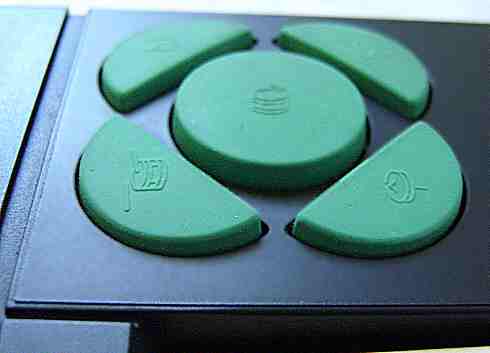 |
 |
eastereggs:
-
Pressing "demo" during a chord plays the demo in that key (very cacophonic).
-
shitshot by power on/ off buttons does much stuff (e.g. changes organ chord
timbre)
modifications:
-
preset volume trimmer adjusted to room volume.
notes:
The user interface of this tablehooter is a bit awkward; the volume
control it has no volume control buttons but the tempo +/- buttons
serve this purpose when pressed while holding the "sound/ master vol."
button (which normally switches cipher buttons to sound select mode). For
rhythm/ accompaniment volume control hold down "rhythm/ acc. vol." instead
(switches normally cipher buttons to rhythm select). Strange is that the
latter does not control the bass volume of the accompaniments. Theoretically
these 2 buttons could have been omitted anyway, because by the count of
entered digits the hardware should recognize whether a sound or rhythm
number is entered.
Despite the 160 main voice preset sounds include multiple variants of
exciting names like "xylo spring", "analog", "fx piano", "cosmic", "fantasy",
"fant. piano", "cosmic piano", "synth spinet", "space", "peak", "metal
guitar", "odyssey" etc., they are all made from each a static digital 8
bit waveform (Hammond- like timbres; I found 21 of them in the ROM plus
a sine wave among percussion samples that may be used as the base drum)
combined with one of only few different attack- decay envelopes, thus most
presets sound not remotely natural. It is not worth the effort to explain
them in detail here, because at first hear they all simply resemble either
cheap tooting analogue home organ tones or Rhodes piano sounds (with
different decay rates), but unlike these they contain much digital aliasing
noise. The preset sounds contain neither vibrato nor tremolo nor any pitch
changes (not to say complex stuff like mandolin ring) and with sustain
off all notes stop immediately after releasing a key. I guess they employ
only about 5 different envelopes {envelope- less toot, toot with
slower attack rate, 3 differently fast decay envelopes}. I consider this
almost a fraud, because the sounds are way too similar to deserve 160 differently
named ones (the individual sounds of an MC-3
differ more). Instead of this annoying pseudo- sound- bank Bontempi
better should have added 4 synth buttons (envelope +/- and timbre +/- like
the "voice variator" on Yamaha PSS-80)
to combine every waveform with every envelope in an easy and logical usable
way, but apparently Bontempi attempted to visually compete by raw
force with
Casio and Yamaha instruments although they had
no technical means to do so. And by the too high preset volume the blatant
sound flaws get even more obvious, because the thing always comes up at
maximum volume after power- on, which makes the small speaker distort unless
the digital volume control is set so low that the this way reduced bit
resolution ruins the sound quality instead. Likely this was intended to
yell together all shopping center customers to make them quickly turn their
head and look for the sudden noise source, but I severely doubt that when
found this made them in any way interested in buying one of these tablehooters
- not to forget that it certainly made the shop staff as quickly decide
to remove all batteries and power supply from such a roaring beast in the
display shelf to make it stay quiet for the rest of the season until it
collects dust. The peak of impudence is that Bontempi advertised
this yelling beast on the box with the feature "high fidelity speaker for
the best sound"; in the German language version instead it is called "Hochleistungs-
Lautsprecher" (in English "high-power speaker"), which is at least a less
incorrect description.
The percussion is monophonic and made from 8 bit low- res samples; especially
the tom drum distorts extremely (clipping) and the cymbal decay phase drowns
in hissing aliasing noise. The lo-fi drums sound quite fat and bassy and
may be nice for tekkno. Annoying is that the tempo can be set not much
lower than medium, although it can be otherwise set quite high.
The accompaniments of different rhythms contain different sounds and
are nicely made. There is even an "intro/ fill-in" button for the rhythms.
Without rhythm the accompaniment plays always the same organ chord timbre,
that makes a quiet popping noise during chord changes. The finger combination
to play a chord depends on "System 5 " knob setting. The mode "free chord
II" is classic fingered chord mode; you even can play any non- chord key
combinations, although with accompaniment plays monophonic with non- chords.
Without rhythm the organ chords hold until releasing all keys in the accompaniment
section. Like with Bontempi GT 509,
you can assign chords to 6 rubber button pads. For this set the "System
5" knob to "easy chord program", "single finger" or "free chord I" and
pressing "record". Then play a chord in the accompaniment section of the
keyboard and simultaneously press the pad you want to assign it to. Press
"record" again to finish. (Stored chords are erased by auto power-off.)
hardware details
The Bontempi KS 4600 is based on a "COMUS 2743239, D45004N" CPU
by Texas Instruments (crystal clocked @ 25MHz). Bizarre is that
the separate 32KB ROM (PROM?) IC "TMS27PC256-2NL" was covered with a white
paper sticker "3220 9901", and its real label underneath contains the word
"ALDI", which is a big German supermarket chain that over the years sold
several Bontempi keyboard models in custom printed package boxes.
(My KS 4600 box and case has no hints to ALDI on it.)
The CPU pinout (clock pins etc.) hints to a 16/32 bit DSP of the documented
Texas Instruments TMS320C1x family. These may be TMS320C10 (288 byte RAM,
3KB ROM, 8KB external program ROM), TMS320C15 (512 byte RAM, 8KB ROM, 8KB
external program ROM) or less likely TMS320C17 (which additionally supports
serial and coprocessor port and µ-law/A-law (de)compression but no
external program ROM). The external ROM here however even is 32KB big,
which hints to bank switching tricks. At the CPU 'D' pins are 2 resistor
arrays for keyboard matrix pullup.
The ROM (I dumped it) contains beside program code about 21 waveforms in
8 bit. There is also a sine wave in the percussion section of the ROM,
so the dull base drum may be simply a very short and low sine wave blip.
But the sine may be also a lookup table for fast multiplication by phase
shifted sine addition. Strange is that the 4 percussion samples in the
rom are way less distorted than the actual sound output, which is apparently
mangled by horrible digital sound processing.
The PCB has trimmers for tuning and volume preset. You can add here
a real volume potentiometer or at least turn down the preset volume (very
recommended), because the given volume control badly reduces the (anyway
low) DAC bit resolution of the sound. With internally adjusted volume the
sound turns at least bearable. |
The demo music plays a very long medley of partly very short songs those
employ standard accompaniments with monophonic main voice.
-
The Old Folks at Home
-
Song of Joy
-
[funk]
-
[funk]
-
[funk]
-
It's a Groovy Kind of Love
-
?
-
[bigband]
-
[boogie]
-
American Farewell (?)
-
Love Me Tender
-
Auld Lang Syne
-
Yankee Doodle
-
When the Saints Go Marching In
-
[march]
-
La Paloma [long and nice]
-
[a known country song]
-
[fast latin music]
-
Lambada (sort-of)
-
[rock organ]
A 49 fullsize keys version of this keyboard was the Bontempi KS 5600.
Bontempi KS 4400
This midsize tablehooter from 1987 (CPU copyright date) is a simplified
variant of Bontempi KS 4600. It lacks
drumpads and has only 96 (anyway fake and boring) preset sounds, 16 rhythms
and no demos.
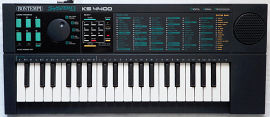
By the lack of external ROM, this model has even crappier low-res percussion
(resembling Bontempi ES 3300).
To camoflage its lousy timbres, Bontempi apparently designed it not to
run without accompaniment, which can be circumvented.
different main features:
-
96 preset sounds
-
16 preset rhythms
-
lousy lo-fi percussion
-
CPU= "Texas Instruments, COMUS2743244, D45007, ©1987 TI WU 9246, 00041
Philippines" (40 pin DIL, likely TMS320C1x)
-
no external ROM
-
no demos
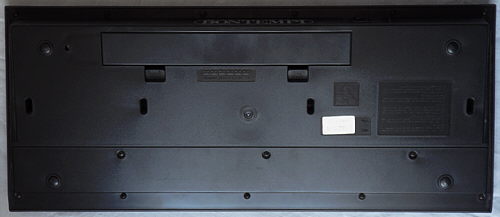
eastereggs:
-
rhythm without accompaniment:
To start pure rhythm, simply select "free chord I", press "key start/stop"
(acts as synchro start) and play in the chord section a non-chord key combination.
hardware details
The single chip CPU "Texas Instruments, COMUS2743244, D45007" (crystal
clocked @ 25MHz) here is not socketed anymore. PCB and case layout were
designed to have drumpads, those were omitted for cutting cost or avoid
stressing the shameful percussion quality. As far I remember, even with
added matrix diodes and jumpers the CPU does not recognize them. Unlike
KS
4600 it lacks the external ROM; also this CPU looks like TMS320C1x
family; which can have maximum 8KB internal ROM.
Trimmer R6 is for tuning and R2 for volume control. |
Bontempi released many other keyboard variants with the same case design
like KS 4600 but different count of preset sounds, different controls
and often different sound generator. E.g. there is the Bontempi
KS 3400 (32 keys, smaller, no drumpads). Apparently the successor
series (blue pads and writing) were Bontempi AT 606 (32 keys, 60
sounds, 30 rhythms, buttons instead of knob, no drumpads), AT 707
(40 keys, 60 sounds, 30 rhythms, 30 "arrangements" (= accompaniments?),
drumpads left next to the speaker),
Bontempi BT 704 (40 keys, 24
sounds, 24 rhythms 6 combined drum/ chord pads),
BT 704/S (40 keys,
36 sounds, 24 rhythms). Later variants were already based on the nice sounding
666 sounds hardware like Bontempi GT
509 (with green panel stuff: Bontempi - Kids Music KT 32
(32 keys),
KM 40 (40 keys) | with blue panel stuff:
BT 605
(32 keys),
BT 705 (40 keys)) A smaller and even worse sounding keyboard
based on the KS 4600 sound engine was Bontempi
ES 3300.
| removal
of these screws voids warranty... |
|
|
 |

|
|
| |
back
|
|
